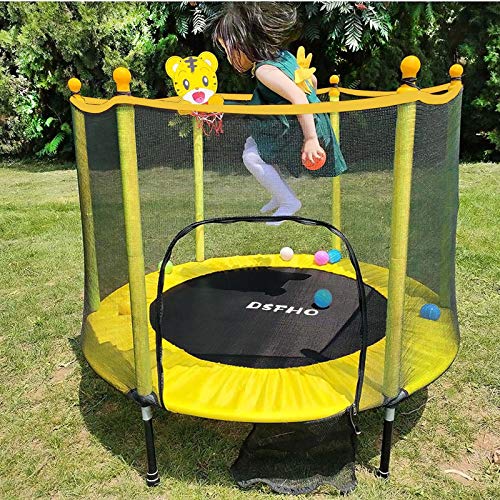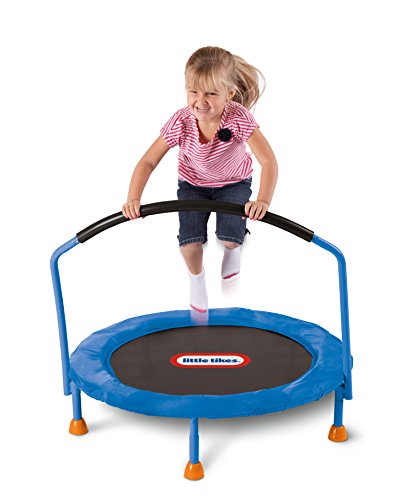Bounce is one of the things that a toddler enjoys doing. On a hot Summer day, you’ll find kids jumping from your furniture, calculating how many steps they can safely jump over, or jumping off your deck into the sprinkler.
Some children’s small trampolines are created particularly for toddlers. These “learn to bounce” items generally feature a 36-inch circumference and a safety bar to grasp onto while using. That makes the trampoline a safe product to use, but is it healthful for children to jump on one?
Parents Should Think Twice About Toddlers and Outdoor Trampolines
Toddlers and outdoor trampolines aren’t always the ideal match for a pleasant pastime, despite trampoline manufacturers’ best efforts. Toddlers’ bones are softer than those of older children and adults. Because the bone is porous rather than solid, it is more vulnerable to compression.
That implies that if the stress applied to a toddler’s bone is exactly perfect, the bone might easily fail.
In 2014, the Consumer Product Safety Commission’s National Electronic Injury Surveillance System documented more than 100,000 trampoline-related injuries that necessitated a trip to the emergency department. Children were involved in 85 percent of the injuries. Preschoolers and toddlers accounted for 42% of the injuries, with bone fractures being the most common.
This data reveals that a child is 7 times more likely than a soccer player to get an injury in terms of leg fractures. The most serious danger for a youngster is not bone-breaking. The reality is that the growth plate is involved in many fractures.
What Happens If a Toddler Gets a Growth Plate Injury?
The growth plate is made up of soft cartilage tissues that wrap around the ends of children’s bones. As the kid develops, these cells solidify into bone, resulting in a longer bone that can support the child’s increased weight. If these tissues are damaged as a result of a fracture, the way the bone develops in the future may be affected.
In extreme cases, a youngster with femur growth plate damage may notice that one leg grows longer than the other.
According to the American Academy of Pediatrics, all children under the age of five should not be on a recreational trampoline. This includes trampolines found in the backyard or in a recreational park.
On a trampoline, having several jumpers increases the chance of harm.
Even with adult supervision, the majority of trampoline accidents to toddlers and preschoolers occur.
As parents, we want our kids to have a good time. We want them to have the same opportunities that we did as children. Some of us leaped onto the trampoline from our roof. For a good chuckle, we did a variety of pranks and stunts. The trampoline is associated with wonderful recollections.
The small trampoline is a good location to start before introducing youngsters to outdoor trampolines or other recreational trampolines. This sort of trampoline, although being an inside product, teaches youngsters body control. When they’re old enough for the bigger trampolines, they’ll be prepared to use them safely.
How to Protect Yourself From Trampoline Injuries
If you currently have a trampoline and want to keep using it, there are a few safety precautions to keep in mind:
- Allow just one person to leap at any given moment.
- Check to see if the springs have been coated.
- Install a safety net around the trampoline’s perimeter.
- Ascertain that the trampoline is placed on flat ground.
- Avoid flips or somersaults.
- Adult supervision is required at all times.
Despite adult supervision, many injuries still occur, according to Dr. Goodwin. Many home insurance plans do not cover trampoline-related damages due to the overall risk.
The absolute safest way to avoid trampoline injury? Keep your distance from them.
Final Thoughts
Trampolines are a great way for kids to get some exercise, especially if they don’t have access to an outdoor yard. Jumping on a trampoline is a great way to let off steam and keep your heart rate up while doing so. It’s a fantastic cardiovascular workout, and there’s a reason trampolines were popular in the past.
Children’s perception and motor skills benefit greatly from trampolines. The vestibular nerve system, which gives information to the brain about location and spatial awareness, is targeted by jumping.
Children learn to feel where their bodies are on a quickly shifting surface when they leap. It necessitates them coordinating their core, muscles, and feet in a way that aids general balance and coordination.

